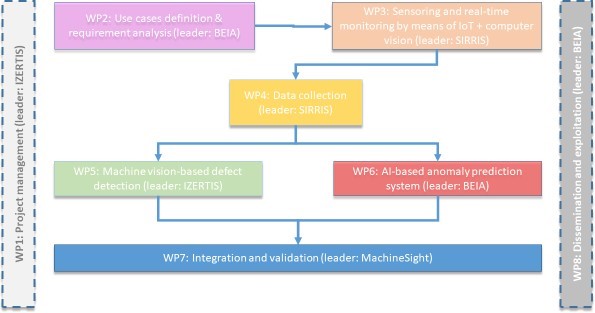This project will address one of the more ambitious challenges in the industry 4.0: the zero defect manufacturing, by applying cuttingedge information and communication technologies, such as machine vision, artificial intelligence (AI) and IoT, in the development of a multimaterial and multidefect detection and anomaly prediction system.
Main innovation regarding current stateoftheart is that the system to be developed within this project will allow the realtime, simultaneous analysis of multiple types of defects (related to surface, morphology and appearance) in different materials, without the need to have different inspection stations for each type of defect. This system will be scalable and customisable for the quality control of any part manufactured in a production line.
On the other hand, the application of AI will allow establishing a correlation between the variables of the production process and the anomalies that the manufactured parts could present, that is, addressing the prediction of faults before they occur.
The use of IoT technologies for monitoring and realtime sensoring the manufacturing lines linked to the use cases to be defined at the beginning of the project will be essential to guarantee obtaining adequate datasets in terms of size, quality and labelling which allow feeding both the defect detection and the anomaly prediction modules, and thus result in a robust and reliable system.
Most common currently existing business cases on defect detection are described below:
There is a company whose quality control processes are based on manual checking techniques of the parts manufactured in its production line.
The company wants to automate its quality control process, because of scalability, consistency and flexibility reasons.
After analysing commercial solutions, it is found that existing systems are able to evaluate a specific defect in a specific station (for example, detection of pores larger than a certain diameter) and they are only effective with previously identified cases.
In summary, main limitation of current systems is that the industrial company needs to acquire several quality control devices and integrate them in its production line in order to be able to detect multiple types of product defects.
Moreover, they present other limitations that will be addressed within this project as well, such as balancing real time processing speed requirements (since the system has to be integrated in an industrial production line) and processing extremely large amounts of data, or lack of specialised narrowdomain specific datasets, needed to build a robust defect detection system.
Being aware of this opportunity, the five entities than comprise the project consortium will work together in the development of a system that will allow the multimaterial quality control of a production line, including defect detection in parts and the anomaly prediction based on the process variables.
The end users involved in the project will play a key role to ensure a marketoriented approach, since their requirements will be taken into account as a starting point of the project and the validation to be performed in their production lines will guarantee that their specific needs are met. The results thus collected will lead to marketoriented conclusions, on which a realistic exploitation plan will be built, including identification of potential customers and business models analysis, in order to define the steps to be taken for a future, successful commercialisation of the results of the project.
In order to achieve main aims described above, the following specific objectives have been defined:
Design and development of a new system based on machine vision and deep learning for the real time, multidefect and multimaterial defect detection and anomaly prediction in a single station. The system will incorporate image analysis techniques capable of detecting that a defect (whatever) occurs in a manufactured part and predict the appearance of anomalies based on the production process variables. Development of a semisupervised labelling procedure, which will allow the generation of knowledge on
the new anomalies detected by the system, so it will have the capacity to incrementally and flexibly learn (active learning) to categorise defects and thus meet the specific needs of each productive process in terms of quality control.
Deployment of AI models in physically located (attheedge) computing hardware in the production line to reduce response time and allow processing speeds appropriate to strict industrial requirements (that is, guaranteeing a fixed response time and reducing latency to a minimum).
Medium/long term storage (local, cloud or mixed) of the information collected for its subsequent analysis. System validation in two very different use cases (both from the point of view of the part material and of the defects and anomalies that they could present): plastic microinjected parts with micro details and metal parts production and processing.

